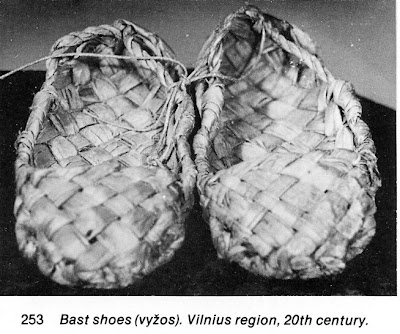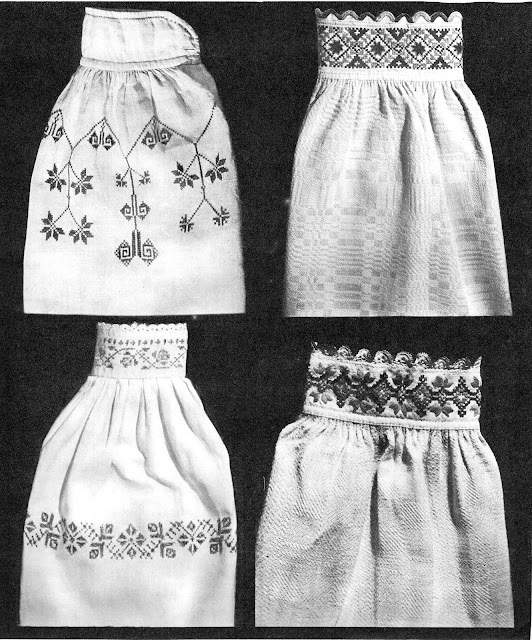Today i am going to talk about the costume and woven ornament of the Vilnius region. Not all sources even recognise such a region, which had me wondering where it came from. After a bit of research, i found out that this is a historical region, being an administrative province which predated the establishment of the independant state of Lithuania in the 20th cent. Here is a good article on the history of this region.
http://en.wikipedia.org/wiki/Vilnius_Region
Here is a map showing the Vilnius region, which is sometimes divided between Dzukija and Aukštaitija.
As i said before, some of my sources do not recognise this as a region, and Jurkoviene and Kulikauskiene in particular do not illustrate any costumes that resemble these at all. Tamošaitis writes that because of their proximity to the capitol, and the clothing of townspeople and aristocracy, "Their costumes therefore were characterized by a more ornate appearance in the cut, colors, and patterns than costumes found elsewhere in Lithuania" and "Those of the Vilnius region were easily distinguisable by the exceptionally beautiful patterns, colours, cut, and style of their clothes." In the south and east of the province especially were large numbers of Poles, Belorussians and others, the various nationalities tended to live each in their own local areas.
Here are a few examples of the Vilnius costume as presented by V Palaimas.
This costume is a favorite of those who took traditional Lithuanian hand weaving for clothes and other textiles and developed it as a national art form in the 20th cent. Here is a set of clothing woven by Anastasia Tamošaitiene and presented to princess Diana of The United Kingdom on the occasion of her wedding. You can clearly see the exceptional care, planning and artistry that went into the weaving of every single piece of this outfit.
For the same reason, this costume is very popular among amateur dance groups and Lithuanian musem exhibits, especially in the Lithuanian Diaspora. Here are some examples.
[These are images i found on the web, if anyone would like me to remove any of these images, or to include information about the origin of, or the people in, these images, please contact me and i will be glad to oblige]
It would be very difficult not to be impressed by the elaborate pattens, tasteful compositions and striking colors of these outfits.
The basic article of dress is the chemise, which has the usual cut for Lithuania, with narrow shoulder bars on top of a single piece, front and back. The bottom half was typically made of coarser material. The festive sleeve is fuller than the daily, and is gathered on top at the seam with the body.
The festive chemise has woven ornament on the shoulder pieces, collar, cuff, front opening, and lower sleeve. Sometimes the ormament is made by hemstitching. On festive chemises, the collar and cuffs sometimes have triangular points or ruched woven ribbon sewn on for added interest.
Here is a graph of the design on the sleeve in the photo immediately above.
The skirt was full, and either woven in a small plaid, as in Dzukija, or with horzontal stripes, sometimes with cats paw or other designs woven in, sometimes over vertical ones, or with horizontal bands of patterned ornament, which are also foud in eastern Aukštaitija. For those of you who weave, i will quote a passage from Tamošaitis [I do not, myself weave, and only vaguely comprehend, lol. This author constantly refers to weaving techniques]
"Twill or satin striped skirts woven from wool on linen were unlike the skirts of any other area. The linen warp was striped and threaded on four shafts in a straight draw. The background of the skirt was of a plain weave, while the stripes were woven in twill or satin with homespun wool. The stripes on the visible side of the cloth appeared raised and distinct; as a result, the skirt did not seem checked, but horizontally striped."
The aprons were elaborately woven with bands of ornament, wider and denser at the bottom, and narrower and sparser towards the top.The same was true of those skirts which had horizontal patterned bands. The aprons were commonly woven from linen, or at least with a light colored background. Red and blue seem to be the commonest colors used overall. Peruse the various images to get an idea of the diversity of designs used. Note also the textures inserted between the ornamental bands.
The sashes are typical for Lithuania, wide, patterned in pick up and other techniques, usually with supplemental weft fringes inserted near the ends.
The bodice was made of handwoven cloth to complement the colors of the skirt and apron. The most common cut has a plaston in a solid color inserted behind the bands in the center front. Sometimes the bodice has a plain straight front closure. Usually it has pentagonally shaped lappets around the waist, but sometimes has a frill with pleats spaced about the same distance as the width of the lappets. See the various images.
The most common headgear in this region for girls is the karuna, made of a hoop of birchbark, and later, cardboard, with pattened ribbon sewn on the inside and outside, one or more rows of trianges sewn on to the top, of the same material or different, and often edged with tatting or crochet. Pattened woven ribbons were attached to the back.
The following three photos show a karuna in various stages of preperation by Vida Rimas.

The headcloth, or wimple, nuometas, is worn in this region as it is in Aukštaitija, but it is smaller in this region, resembling the one worn in Latgalia. It is always heavily ornamented on the ends, and commonly has a frontpiece resembling the karuna sewn on, or a wreath resembling the karuna worn over it. Originally this would have been a seperate piece worn underneath. The nuometa with a frontpiece sewn on, front and back.
The nuometas attached to a karuna. The difference is that the hair is covered.
The nuometas worn with a seperate wreath over it
A schematic showing how the wreath was made, again very similar to the karuna.
The linen wrap, panuometis was also worn in this region, and also highly ornamented
The costume was completed with necklaces of amber or coral or glass. Footwear consisted of knitted socks, with shoes, moccasins, clogs, or shoes woven of birch or linden bark. Moccasins in this region were also highly ornamented.They also wear slippers looped, knitted or crocheted of linen strings, as in Dzukija.
Thank you all for reading. I hope you have found this interesting and maybe have an inspiration on how to use some of these designs or concepts.
Feel free to contact me with requests for research. I hope to eventually cover all of Europe and the Former Russian Empire/Soviet Union. I also gratefully accept tips on source materials which i may not have. I also accept commissions to research/design, sew, and/or embroider costumes or other items for groups or individuals
Roman K.
Rkozakand@aol
Source Material:
AntanaTamošaitis and Anastazija Tamošaitienė, 'Lithuanian National Costume', Toronto, 1979
Vida Kulikauskienė et al, 'Lithuanian National Costume', Vilnius, 1994,
Kati Reeder Meek, 'Reflections from a Flaxen Past, For Love of LIthuanian Weaving', Alpena, Michigan, 2000
Teresė Jurkiuvenė, 'Lithuanian National Costume', Vilnius, 2006
Mikalina Glemžaitė, 'Lietuvių Tautiniai Drabužiai', [Lithuanian National Clothing] Vilnius, 1955
Stasė Bernotienė, 'Lietuvių Liaudies Moterų Drabužiai XVIII a XX pr.' [Lithuanian Women's Folk Clothing from the XVIII to the XX cent], Vilnius, 1974,
Stasė Bernotienė, 'Lietuvių Valstiecių Išeiginės Prijuostės XIX a. - XX a. pradžia' [Lithuanian Aprons of the 19th and 20th cent], Vilnius, 2007
J. Grigienė et al, 'Lietuvių Liaudies Menas - Drabužiai' [Lithuanian Folk Art - Clothing], Vilnius, 1974
Elena Matulionienė, 'Klaipėdos Krašto Tautiniai Drabužiai' [Folk Clothing of the Klaipeda Region], Klaipeda, 2005
V. Palaimas, artist, set of postcards, 'Lithuanian Folk Costume', 1961
R. Paknys, photographer, set of postcards, 'Lietuvių Tautiniai Drabužiai', 1991
Tatyana Razina et al, 'Folk Art in the Soviet Union', Leningrad, 1990
Irma šidiškienė, 'Buti LIetuve', Vilnius, 2004











































































